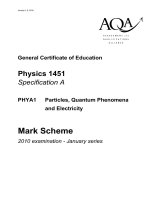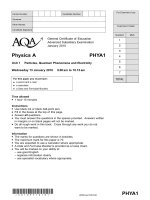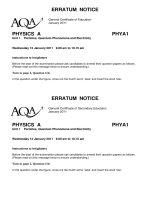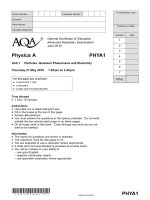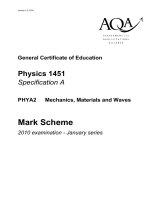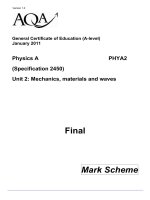- Trang chủ >>
- Khoa Học Tự Nhiên >>
- Vật lý
Vật lý A level: AQA PHYA5 2b w QP JUN11
Bạn đang xem bản rút gọn của tài liệu. Xem và tải ngay bản đầy đủ của tài liệu tại đây (521.95 KB, 12 trang )
WMP/Jun11/PHYA5/2B
PHYA5/2B
Centre Number
Surname
Other Names
Candidate Signature
Candidate Number
General Certificate of Education
Advanced Level Examination
June 2011
Time allowed
●
The total time for both sections of this paper is 1 hour 45 minutes.
You are advised to spend approximately 50 minutes on this section.
Instructions
●
Use black ink or black ball-point pen.
●
Fill in the boxes at the top of this page.
●
Answer all questions.
●
You must answer the questions in the spaces provided. Do not write
outside the box around each page or on blank pages.
●
Do all rough work in this book. Cross through any work you do not
want to be marked.
Information
●
The marks for questions are shown in brackets.
●
The maximum mark for this section is 35.
●
You are expected to use a calculator where appropriate.
●
A Data and Formulae Booklet is provided as a loose insert.
●
You will be marked on your ability to:
– use good English
– organise information clearly
– use specialist vocabulary where appropriate.
For this paper you must have:
●
a calculator
●
a ruler
●
a Data and Formulae Booklet.
Physics A PHYA5/2B
Unit 5B Medical Physics
Section B
Monday 27 June 2011 9.00am to 10.45am
MarkQuestion
For Examiner’s Use
Examiner’s Initials
TOTAL
1
2
3
4
5
(JUN11PHYA52B01)
WMP/Jun11/PHYA5/2B
Do not write
outside the
box
Section B
The maximum mark for this section is 35 marks. You are advised to spend approximately
50 minutes on this section.
1(a) A person suffering from long sight has an unaided near point 63 cm from the eye.
Figure 1 shows three diagrams not drawn to scale. The first two diagrams show rays
incident on the unaided eye. The third diagram shows rays incident on the correcting
lens which will allow the person to have an aided near point 25 cm from the eye.
Complete the diagrams to show the passage of the rays to the retina. You may assume
that for the eye there is only a single refraction at the cornea of the eye.
Figure 1
(2 marks)
1(b) Calculate the focal length of the correcting lens, stating the answer to the
appropriate number of significant figures.
answer = m
(3 marks)
(02)
2
63 cm 25 cm
WMP/Jun11/PHYA5/2B
Tur n over
ᮣ
(03)
Do not write
outside the
box
1 (c) Explain what is meant by persistence of vision and state a practical situation where it is
important.
(2 marks)
Turn over for the next question
3
7
WMP/Jun11/PHYA5/2B
Do not write
outside the
box
2(a) Define the threshold of hearing, I
0
.
(2 marks)
2(b) A hearing test was used to obtain threshold hearing audiograms for several people. The
audiogram shown in Figure 2 was obtained for a person with normal hearing.
On the same axes:
2 (b) (i) sketch a curve, labelled A, for a person suffering hearing loss due to old age
(1 mark)
2 (b) (ii) sketch a curve, labelled B, for a person suffering hearing loss due to excessive
noise.
(2 marks)
Figure 2
4
(04)
0 100 1000 10 000
frequency
/ Hz
30 300 3000
intensity
level /
dB
0
40
80
120
5
WMP/Jun11/PHYA5/2B
Do not write
outside the
box
3 An endoscope contains two bundles of optical fibres.
3(a) Name the two bundles. For each bundle state clearly the arrangement of the fibres and
explain its purpose in the operation of the endoscope.
Bundle 1
Bundle 2
(4 marks)
3(b) Each fibre has a core surrounded by cladding.
Calculate the critical angle at the core – cladding interface of a fibre.
refractive index of core = 1.60
refractive index of cladding = 1.55
answer = degree
(1 mark)
5
Tur n over
ᮣ
(05)
5
WMP/Jun11/PHYA5/2B
Do not write
outside the
box
4(a) An ECG trace is to be obtained for a patient. State and explain the procedure and some
design features of the equipment needed to ensure a good trace is obtained.
The quality of your written communication will be assessed in this question.
(6 marks)
6
(06)
WMP/Jun11/PHYA5/2B
(07)
Do not write
outside the
box
4(b) Figure 3 shows an ECG trace for a healthy person.
Figure 3
4 (b) (i) Add a suitable scale and unit to the potential axis.
(2 marks)
4 (b) (ii) Add a suitable scale to the time axis.
(1 mark)
4 (b) (iii) State the electrical events which give rise to the points:
P
R
T
(3 marks)
Turn over for the next question
7
time / s
P
R
T
potential
at body
surface
12
Tur n over
ᮣ
WMP/Jun11/PHYA5/2B
(08)
Do not write
outside the
box
8
5(a) The X-ray spectrum for a certain X-ray tube target is shown in Figure 4. Explain the
process which gives rise to spikes at certain photon energies.
Figure 4
(3 marks)
photon energy / keV
0
0
X-ray
intensity
WMP/Jun11/PHYA5/2B
Do not write
outside the
box
9
Tur n over
ᮣ
(09)
5(b) A film cassette, placed under a patient being X-rayed, is shown in Figure 5.
Figure 5
5(b) Explain how the intensifying screens in the film cassette achieve their purpose and state
their benefit to the patient.
(3 marks)
END OF QUESTIONS
plastic front cover
front intensifying screen
double sided film
rear intensifying screen
metal back
6
WMP/Jun11/PHYA5/2B
Do not write
outside the
box
10
(10)
There are no questions printed on this page
DO NOT WRITE ON THIS PAGE
ANSWER IN THE SPACES PROVIDED
WMP/Jun11/PHYA5/2B
Do not write
outside the
box
11
(11)
There are no questions printed on this page
DO NOT WRITE ON THIS PAGE
ANSWER IN THE SPACES PROVIDED
WMP/Jun11/PHYA5/2B
Do not write
outside the
box
12
(12)
There are no questions printed on this page
DO NOT WRITE ON THIS PAGE
ANSWER IN THE SPACES PROVIDED
Copyright © 2011 AQA and its licensors. All rights reserved.
